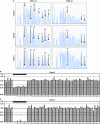High frequency of COH1 intragenic deletions and duplications detected by MLPA in patients with Cohen syndrome
- PMID: 20461111
- PMCID: PMC2987453
- DOI: 10.1038/ejhg.2010.59
High frequency of COH1 intragenic deletions and duplications detected by MLPA in patients with Cohen syndrome
Abstract
Cohen syndrome is a rare, clinically variable autosomal recessive disorder characterized by mental retardation, postnatal microcephaly, facial dysmorphisms, ocular abnormalities and intermittent neutropenia. Mutations in the COH1 gene have been found in patients from different ethnic origins. However, a high percentage of patients have only one or no mutated allele. To investigate whether COH1 copy number changes account for missed mutations, we used multiplex ligation-dependent probe amplification (MLPA) to test a group of 14 patients with Cohen syndrome. This analysis has allowed us to identify multi-exonic deletions in 11 alleles and duplications in 4 alleles. Considering our previous study, COH1 copy number variations represent 42% of total mutated alleles. To our knowledge, COH1 intragenic duplications have never been reported in Cohen syndrome. The three duplications encompassed exons 4-13, 20-30 and 57-60, respectively. Interestingly, four deletions showed the same exon coverage (exons 6-16) with respect to a deletion recently reported in a large Greek consanguineous family. Haplotype analysis suggested a possible founder effect in the Mediterranean basin. The use of MLPA was therefore crucial in identifying mutated alleles undetected by traditional techniques and in defining the extent of the deletions/duplications. Given the high percentage of identified copy number variations, we suggest that this technique could be used as the initial screening method for molecular diagnosis of Cohen syndrome.
Figures





Similar articles
-
Novel VPS13B Mutations in Three Large Pakistani Cohen Syndrome Families Suggests a Baloch Variant with Autistic-Like Features.BMC Med Genet. 2015 Jun 25;16:41. doi: 10.1186/s12881-015-0183-0. BMC Med Genet. 2015. PMID: 26104215 Free PMC article.
-
Cohen syndrome diagnosis using whole genome arrays.J Med Genet. 2011 Feb;48(2):136-40. doi: 10.1136/jmg.2010.082206. Epub 2010 Oct 4. J Med Genet. 2011. PMID: 20921020
-
An intronic splice site alteration in combination with a large deletion affecting VPS13B (COH1) causes Cohen syndrome.Eur J Med Genet. 2020 Sep;63(9):103973. doi: 10.1016/j.ejmg.2020.103973. Epub 2020 Jun 4. Eur J Med Genet. 2020. PMID: 32505691
-
A novel VPS13B mutation in Cohen syndrome: a case report and review of literature.BMC Med Genet. 2020 Jun 30;21(1):140. doi: 10.1186/s12881-020-01075-1. BMC Med Genet. 2020. PMID: 32605629 Free PMC article. Review.
-
Clinical variability of genetic isolates of Cohen syndrome.Clin Genet. 2011 Jun;79(6):501-6. doi: 10.1111/j.1399-0004.2011.01669.x. Epub 2011 Apr 7. Clin Genet. 2011. PMID: 21418059 Review.
Cited by
-
Cohen syndrome-associated protein, COH1, is a novel, giant Golgi matrix protein required for Golgi integrity.J Biol Chem. 2011 Oct 28;286(43):37665-75. doi: 10.1074/jbc.M111.267971. Epub 2011 Aug 24. J Biol Chem. 2011. PMID: 21865173 Free PMC article.
-
Novel VPS13B Mutations in Three Large Pakistani Cohen Syndrome Families Suggests a Baloch Variant with Autistic-Like Features.BMC Med Genet. 2015 Jun 25;16:41. doi: 10.1186/s12881-015-0183-0. BMC Med Genet. 2015. PMID: 26104215 Free PMC article.
-
Syndromic and Monogenic Obesity: New Opportunities Due to Genetic-Based Pharmacological Treatment.Children (Basel). 2024 Jan 25;11(2):153. doi: 10.3390/children11020153. Children (Basel). 2024. PMID: 38397265 Free PMC article. Review.
-
Two Novel COH1 Mutations in an Italian Patient with Cohen Syndrome.Mol Syndromol. 2012 Jun;3(1):30-33. doi: 10.1159/000338816. Epub 2012 May 16. Mol Syndromol. 2012. PMID: 22855652 Free PMC article.
-
Disease relevance of rare VPS13B missense variants for neurodevelopmental Cohen syndrome.Sci Rep. 2022 Jun 11;12(1):9686. doi: 10.1038/s41598-022-13717-w. Sci Rep. 2022. PMID: 35690661 Free PMC article.
References
-
- Cohen MM, Jr, Hall BD, Smith DW, Graham CB, Lampert KJ. A new syndrome with hypotonia, obesity, mental deficiency, and facial, oral, ocular, and limb anomalies. J Pediatr. 1973;83:280–284. - PubMed
-
- Carey JC, Hall BD. Confirmation of the Cohen syndrome. J Pediatr. 1978;93:239–244. - PubMed
-
- Norio R, Raitta C, Lindahl E. Further delineation of the Cohen syndrome; report on chorioretinal dystrophy, leukopenia and consanguinity. Clin Genet. 1984;25:1–14. - PubMed
-
- Velayos-Baeza A, Vettori A, Copley RR, Dobson-Stone C, Monaco AP. Analysis of the human VPS13 gene family. Genomics. 2004;84:536–549. - PubMed
MeSH terms
Substances
Supplementary concepts
LinkOut - more resources
Full Text Sources

